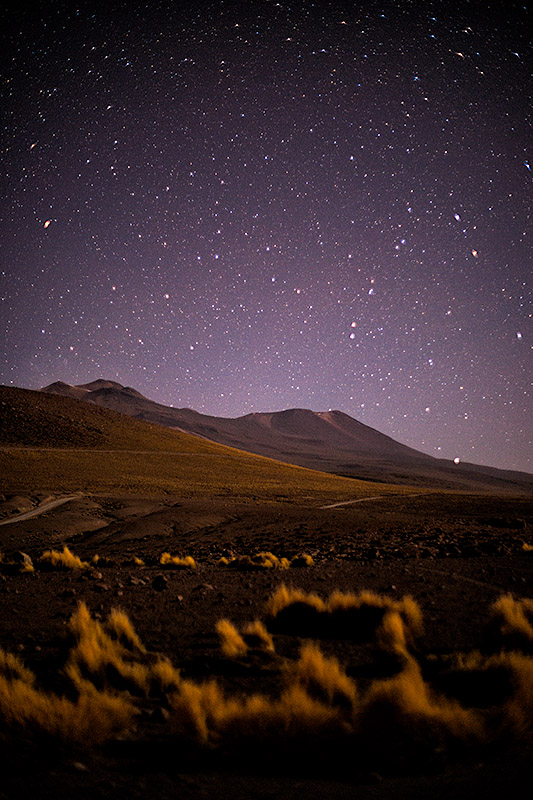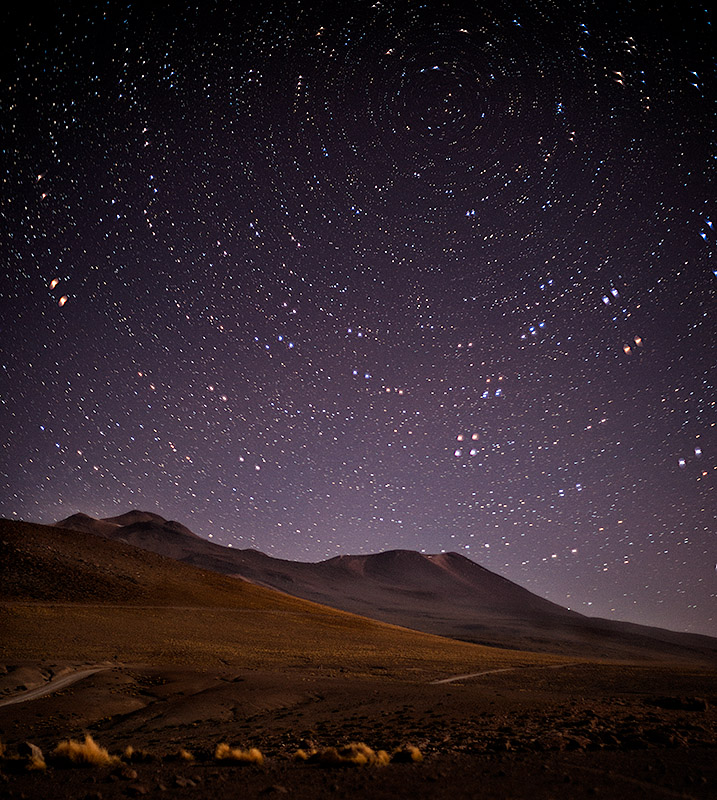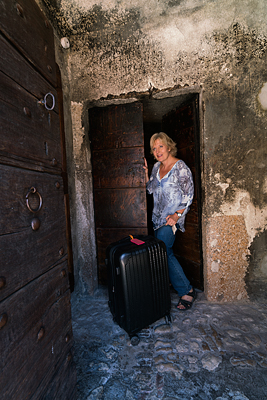
.jpg)
I’ve always admired shots of the night sky, and in particular star trails. Knowing I was headed to the deserts of northern Chile–some of the darkest skies for astrophotography–I began gathering ideas online for capturing such shots. I also purchased a Vello Wireless Shutterboss intervalometer device that would allow me to take continuous shots remotely over a specified period of time.
In northern Chile, my friend, Nannette, and I joined an overnight astronomy tour with Atacama Desert Gazing that took us far away from the lights of San Pedro to a rustic lodge near the Tatio Geyser Field. When still daylight, I prepared my camera for capturing star trails by turning off the noise reduction, image stabilization and auto focus. Then chose a 50mm lens, set the aperature to f1.4 (widest aperature makes the stars brighter), set the shutter speed to 30 seconds, ISO to 400, focused on infinity, and inserted a new battery. I then locked down my tripod, adding weight with rocks to prevent it from blowing over in the wind, and aimed my camera at the south pole (with the help of my guide who indicated where). I then set up the intervalometer to take 60 shots (30 sec each) with a 1 sec delay between frames. Then waited for darkness…
At 10pm, dinner with our guide, Jorge, my friend Nannette, and the wardens of Tatio Geyser came to an end and the astronomy lesson was set to begin. We walked outside and faced an incredible sky. Inky black with bright twinkling stars and a beautiful milky way. Temps had dropped significantly, as it tends to do at high altitude–an elevation of 4320 meters to be exact–and I was glad at my forethought to wear 2 liners under thick fingerless gloves, long johns, a turtleneck, scarf, hat and 2 fleece tops under a winter vest. Nannette, although properly winterized for the cold, decided that a bed piled high with blankets was more appealing and ditched us. Double checking the settings on my Vello device, I then triggered it into action and left after the first shot, knowing it would continue for the next 30 minutes.


This was the first of the intended 60 shots to capture star trails. ISO 400, f/1.4, 30 sec exposure
Guide Jorge was waiting for me on the other side of the rustic lodge with blankets and a lawn chair, and soon dove into a very informative explanation about the southern hemisphere sky, showing me the moon, star clusters, nebulas, and gobular clusters through his telescope. None of the planets were out, so we couldn’t see the rings of Saturn. But it was fascinating to look at the details through different eyepieces Jorge brought out on his telescope. The night sky is truly amazing! He then took out his camera and tripod and invited me to bring my camera alongside him to photograph the night sky. Knowing that nearly an hour had past, and that my star trail sequence should have completed long ago, I retrieved my tripod and joined Jorge. A quick check revealed a grave error in the star trail recording process. Only four shots out of 60 had fired! Rechecking the settings on the valometer, I tried again to no avail. This time, only 2 shots fired. Thinking it might be battery related (it was freezing out here–I could no longer feel my fingers or toes), I inserted a warm battery and tried again. Still, only 2 shots fired. At this point, I had already moved the tripod from proper alignment and wasn’t about to go traipsing in the dark across jagged rocks to find my original position. Jorge instead encouraged me to join him in shooting the Milky Way.
Once home, I decided to merge those 4 photos just for fun to see what would happen. Lo, and behold! Strange polka-dot star trails appeared!
I never would’ve guessed that just 4 photos would create this effect. You’ll notice that I didn’t like the fuzzy grasses in the foreground–too distracting–so I cropped most of them out.


In PhotoShop, I opened all 4 pics as layers. And as I changed each layer’s blending mode to lighten, the polka-dot trails magically appeared! Just imagine this pic if all 60 shots had been taken!
David, my husband, is the knowledgeable one when it comes to equipment, astrophotography, noise control and all things technical. (You won’t find me using complicated mathematical equations to calculate the speed of strobes necessary for capturing subjects like he does!) But he wasn’t here. He did give me a couple pointers before I’d left home when taking shots of the night sky: 1) take 20+ identical shots to later merge in Photoshop to cancel out the noise. 2) pump up the ISO to use 1/30 SS so that the stars won’t move (like they do in a longer exposures such as for star trails!). Seemed simple enough. But, blame it on the altitude, my lightheadedness and foggy brain…I forgot to adjust the shutter speed. Every shot I took that night was 20-30 seconds long.
Trying to capture the Milky Way initially was difficult because of the moon. In a week the moon would be full, so it was plenty bright when still above the horizon as you can see in this shot.


So I continued to shoot well past midnight after it had dipped below the sky. I liked the illuminated window in the rustic lodge (where Nannette was by now fast asleep…:) but wanted to add another layer to make it more three dimensional. So I asked Jorge to bring over his telescope to place in the foreground. During long exposures (I know, I know, why was I using a long 30 sec exposure?) I flashed my miniature flashlight on the telescope, and the side of the lodge if no window light appeared during the exposure. The best pic from those attempts is this image. Even if the telescope looks kinda like a penguin to me (ha, in the Atacama Desert he must be reeeally lost).


After Jorge went in to bed, I decided to stay out and try to capture some star trails manually (since my handy Vello device would only deliver 2 shots before shutting down). I aimed my camera in the basic direction of what I thought was the south pole (no visible star like in the north hemisphere). This was the first shot:


Camera info: 50mm lens, f/1.7, 30 second shutter speed, ISO 400.
In addition to the profusion of stars, there is a cluster of some kind (sorry, Jorge!) in the lower right of the photo, but overall nothing special. But since I took 23 identical images, I merged them in PhotoShop and changed the blending mode of each layer to lighten to see what would happen. And here is the surprising result (with no adjustments whatsoever):


Pretty bizarre, huh? But the perfectionist in me must point out that the composition is poor. A tiny part of a mountain appears in the lower left of the frame (which I never noticed till I got home) and looks more like a mistake than a foreground subject for adding interest or dimension. And the stars trail straight down rather than in a circle. But, what color and clarity! I know I have lots to learn about capturing the night sky, but have to admit it’s cool to see what results with each experiment!
As for the overnight tour itself, I highly recommend Atacama Desert Stargazing. Jorge and his finance were super friendly, knowledgeable, and generous with their time and energy. They picked us up at the airport and spent the day touring us around tiny desert villages and secret spots before ending up at the Tatio Geyser Field where the rustic base camp was located. A delicious dinner with Chilean wine was served and enjoyed with the 4 wardens on duty, who soon crashed asleep in preparation for the busloads of tourists that arrive at 5-6am the next morning (Tatio geysers is one of the most popular tours from San Pedro). The astronomy tour takes place outside under the sky in comfy chairs with blankets around 10-12pm, aided by laser and telescope viewing. You can stay out all night and photograph to your heart’s content (or until the bitter cold forces you inside!) There are 2 bunk rooms which guests share with the wardens (male and female rooms). And another perk? You can sleep in a little later the next morning before touring the geysers, as they are only a ten minute drive away! We asked to view them at 6:30am (the most active time for photography) but Jorge usually takes his guests much later after the busloads have disappeared. Breakfast follows before the long drive to San Pedro. Overall, the whole experience was my favorite in the Atacama Desert, and I thank Jorge for offering such an opportunity!


.jpg)
